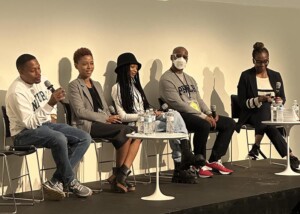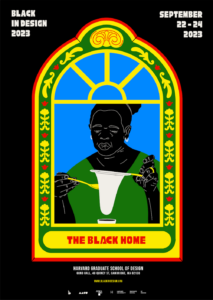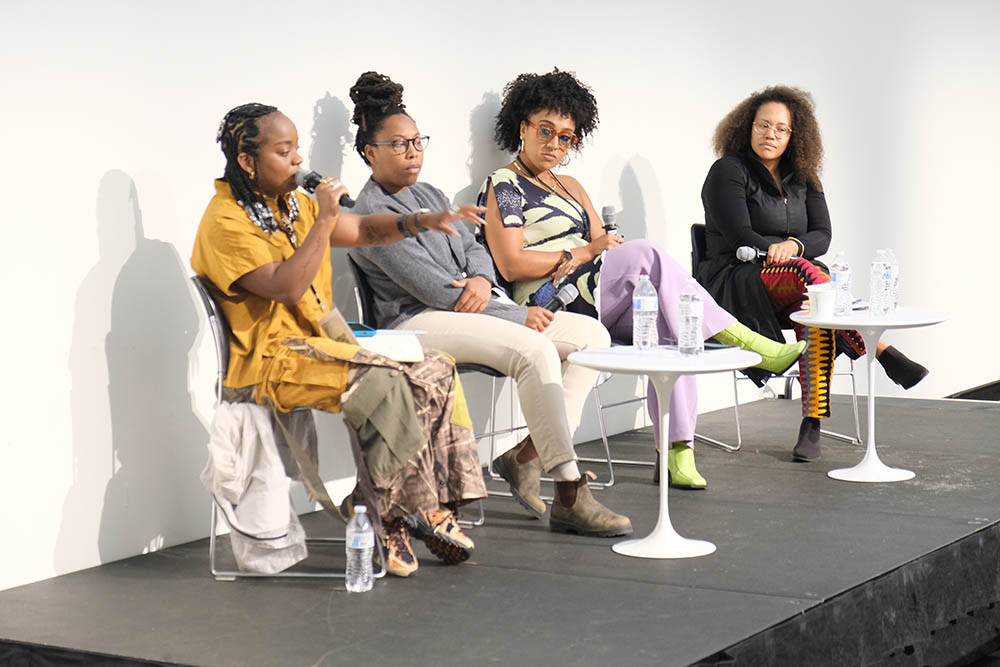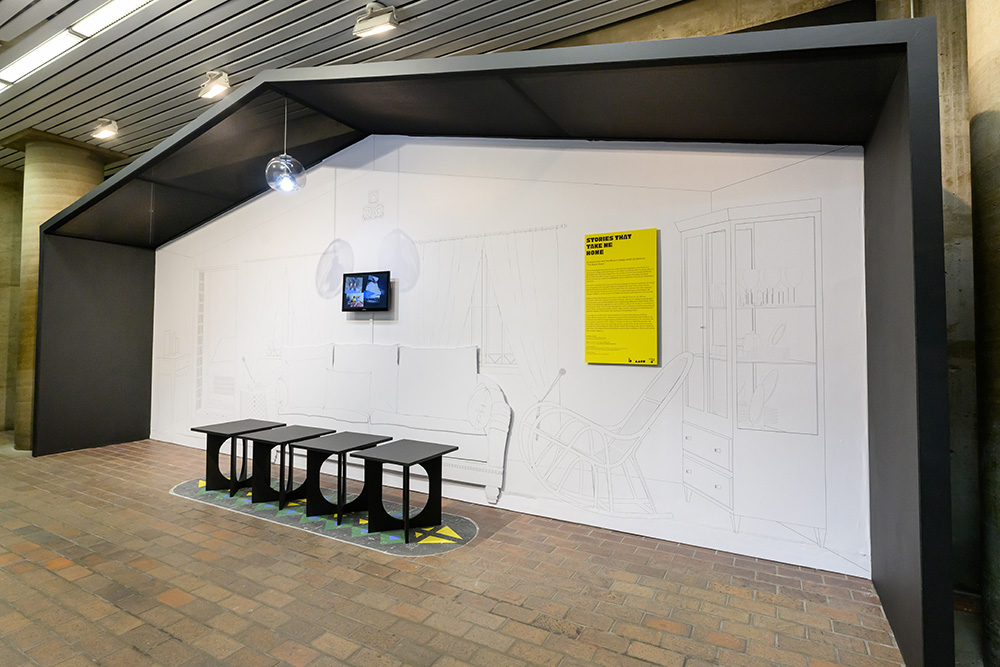
Where is home for you? It’s an ice-breaker question we all get asked at some point, especially at the start of a new academic year. For many it’s a city, a street, a building, or a community. For attendees at this year’s Black in Design conference (BiD), held at the Graduate School of Design from September 22nd through the 24th, answers ranged from Chicago to Nigeria. But home could also be much closer and subtler; for many attendees, home could be evoked by the familiar bottles of Nivea shea lotion the conference organizers added to the GSD’s main floor restrooms.
The African diaspora remains critically underrepresented in traditional design fields such as architecture, landscape design, and urban planning. Since its inaugural session in 2015, the Black in Design conference has worked to create a space where Black designers from all fields, beyond credentialed architects—from visual artists to DJs to family archivists—feel welcome and celebrated.
“I think we all came into the planning process knowing that it was important to reflect on the precedents that we use in our work, and a lot of that was not design-based,” said Kai Walcott (MLA I ’24), one of the conference co-chairs. She noted that despite having professional training in design, a lot of what she draws on to inform her own work and thesis research comes from Black visual and performing arts from outside the academy. Those disciplines, Walcott said, “reflected more of the ideas that I want to… grapple with to understand how Black people use space and make space.” These sources and ways of creating and preserving knowledge are often missing from traditional design curricula, the conference organizers noted, and they sought to develop conference themes that would make practitioners from a wide range of formal and informal disciplines feel comfortable alongside each other.

This year’s theme, the Black Home, came out of listening sessions held between the organizing committee members (current GSD students Dora Mugerwa, MLA I ’24; and Walcott; and recent alumni Tobi Fagbule, MDes ’23 and Michael Johnson, MUP ’23); representatives of Africa GSD; the GSD African American Student Union; and Black GSD students generally, who were asked what topics they wanted to see represented. These sessions revealed a number of themes that ultimately coalesced around the idea of home not just as a building to be designed, but as a synthesis of objects, scents, colors, or feelings. Taken together, these are elements that can make an experience of home simultaneously unique and a source of commonality across a diaspora.
When it came time to choose keynote and panel speakers, Mugerwa said it was important that there was a mix of invitees from both inside and outside the boundaries of what is traditionally considered “design” in the professional field. “We wanted to focus on folks whose work was new to us,” she said, “and show how artists and designers can take inspiration from people outside of the discipline. But we tried to have a balance of design practitioners and non-practitioners as well that could have cross-disciplinary conversations.”
In addition to coming from diverse professional and curatorial backgrounds, the conference organizers invited speakers who also had different visions of what home meant to them. In the keynote panel, “Legacy: Defining the Black Home (Past, Present, Future),” the first question asked by moderator Toni L. Griffin, a Professor in Practice at the GSD and Founder of urbanAC, was: Can home be designed? Panelist Bryan Mason, Co-Founder and Creative Director of AphroChic, responded that like everything in our daily lives, a home and the objects within it can be designed, and that Black people have been doing so for centuries. In contrast, panelist Germain Barnes (the Principal of Studio Barnes, and Associate Professor and Director of the Master of Architecture Graduate Program at the University of Miami School of Architecture) was more skeptical, noting that designers could facilitate other people’s ability to create home, but that for him home ultimately came down to people, feelings, and sensory experiences that cannot be explicitly designed. Renata Cherlise, Founder of the Black Archives multimedia platform and author of Black Archives: A Photographic Celebration of Black Life (2023), drew from memories and how they imbue art, objects, and spaces. “I know Great Grandma’s house is not there but I still go back in my dreams,” she said, noting that her recent book celebrates memories and sensory experiences of place through photographs in Black family archives.

In addition to panels, Black in Design conferences feature hands-on workshops hosted throughout the weekend. This year’s workshops included “Black Feminist Imagination and the Black Home,” led by BlackSpace Urbanist Collective, and “Archiving the Black Home,” led by Wayside studio Founder, public artist, and educator Curry J. Hackett. The sessions gave conference participants a way to not only form cross-disciplinary connections with each other, but to approach their own design practice through potentially new methods such as incorporating artificial intelligence or curating multimedia archival exhibitions.
In searching for workshop leaders, Walcott said, “We wanted people who were doing this work but may not (yet) have the platform of Harvard, to try and connect them,” with the GSD community and a broader design audience.
Between workshops, panels, and food catered by the local restaurant Jamaica Mi Hungry, the conference organizers wanted to ensure the GSD felt like home as well, hence the bottles of lotion in the bathrooms—an immediate hit with attendees. Nina Cooke John, a keynote panelist and Founding Principal of Studio Cooke John Architecture and Design, noted that while she has created architectures of home, recently through Obsidian House, home is also found in gestures of care just like that.
While BiD is a temporary experience, one piece of it remains in Gund Hall in the form of an exhibition called Stories That Take Me Home, on view until October 18th. Curated by the conference co-chairs and designed by Àrà Lab, a project of Fagbule and Sumayyah Súnmàdé Raji (MArch ’23), the exhibition seeks to reclaim images and theorizations of the Black Home in Africa from negative associations with conflict or destitution, or “as mere artifacts, objects for study, or curiosities to be sampled,” according to the curators’ statement. Instead, the exhibit demonstrates “their profound multidimensionality… (reflecting) culture, identity, and traditions and generate(s) spaces of the home that transcend the physical realm.”

Visually, the exhibition is anchored by an outline drawing of a home with an arch and porch yard. “That was something that was very close to our hearts,” Fagbule said. She grew up in Nigeria and said her context for home is always changing, but that there are elements of home that start to appear in different ways throughout her daily life wherever she happens to be living. She wanted viewers to share in that and recall their own stories of home, or treasured objects, over time.
One of the things that made Black in Design successful, Mugerwa added, is the feeling of commonality it fostered. While people may think their home or neighborhood is unique, they could come to this exhibition, and the various conference events, and recognize a sofa, a cabinet in the front room that they were never allowed to touch as a child, a glass figurine, a familiar brand of lotion, and so on. “So we wanted to reinforce that multiplicity, that we are not a monolith,” she said, “but it was nice to see those moments where there was overlap, where we could all identify with something similar.”
Morgan Forde is a third-year doctoral student at the Harvard University Graduate School of Design where her work focuses on the intersections of twentieth-century US urban planning history and the socio-spatial activism of radical Black Power, socialist, and feminist movements. She has been a freelance journalist and editor for several years, and her work has appeared in the Los Angeles Review of Books, Mic, The Nation, Ploughshares, Popular Mechanics Magazine, and elsewhere.